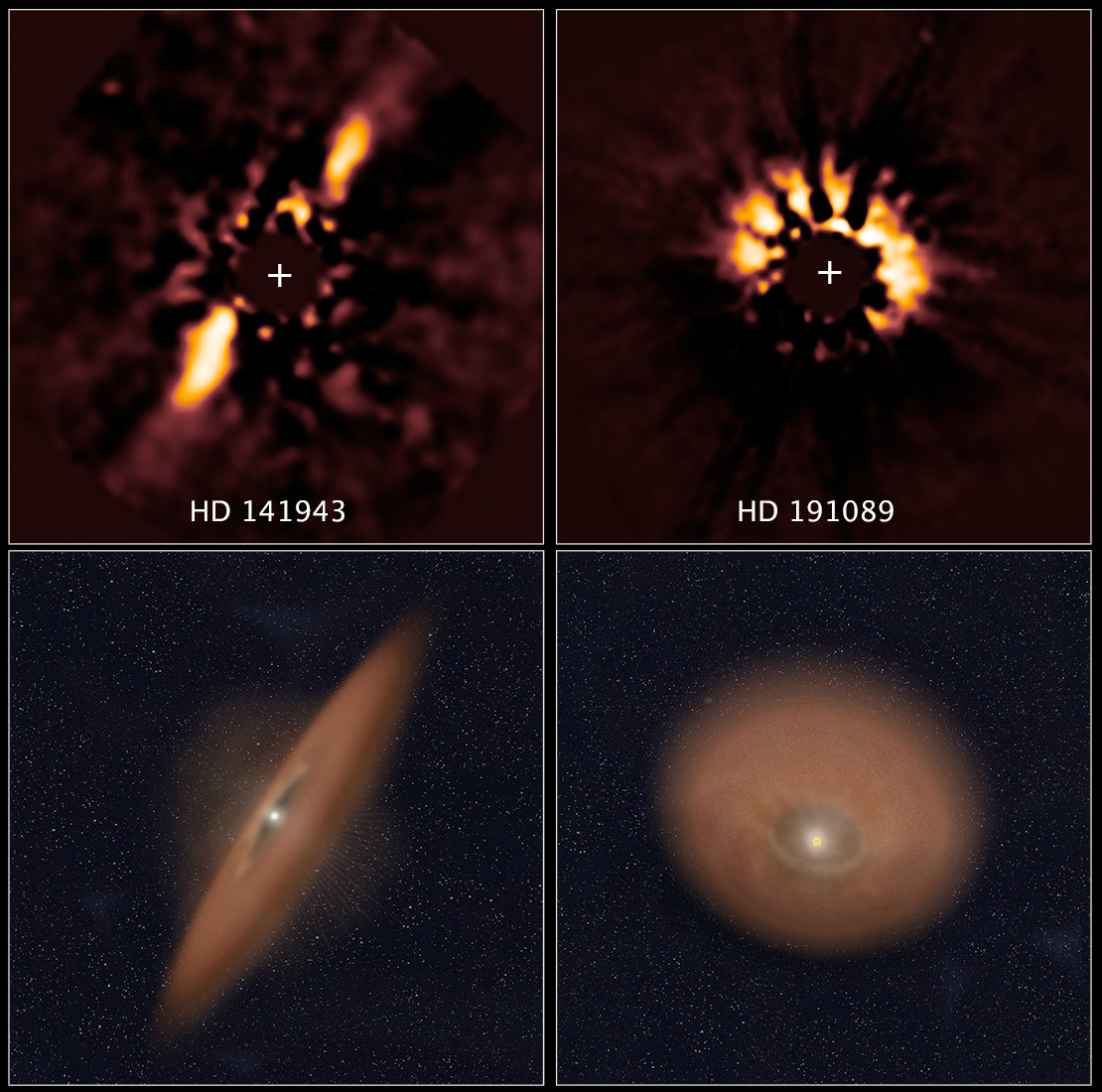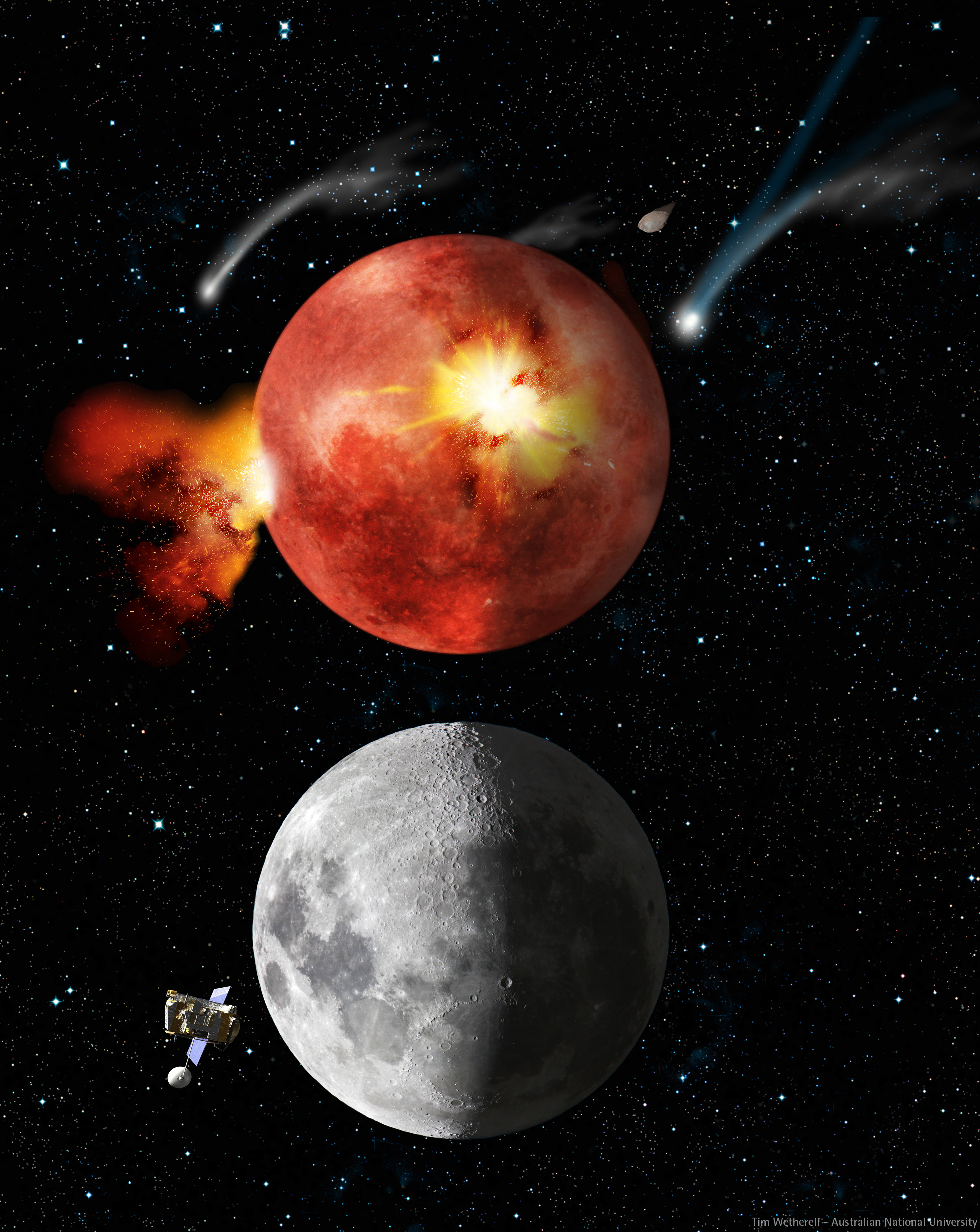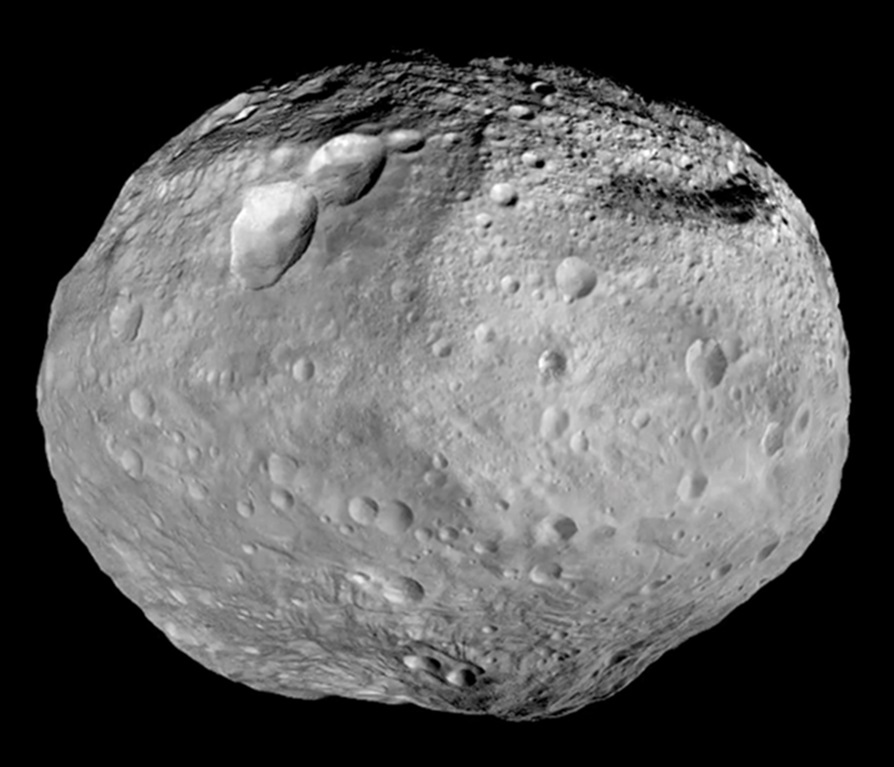|
Planetesimal
Planetesimals are solid objects thought to exist in protoplanetary disks and debris disks. Per the Chamberlin–Moulton planetesimal hypothesis, they are believed to form out of cosmic dust grains. Believed to have formed in the Solar System about 4.6 billion years ago, they aid study of its formation. Formation A widely accepted theory of planet formation, the so-called planetesimal hypotheses, the Chamberlin–Moulton planetesimal hypothesis and that of Viktor Safronov, states that planets form from cosmic dust grains that collide and stick to form ever-larger bodies. Once a body reaches around a kilometer in size, its constituent grains can attract each other directly through mutual gravity, enormously aiding further growth into moon-sized protoplanets. Smaller bodies must instead rely on Brownian motion or turbulence to cause the collisions leading to sticking. The mechanics of collisions and mechanisms of sticking are intricate. Alternatively, planetesimals may form ... [...More Info...] [...Related Items...] OR: [Wikipedia] [Google] [Baidu] |
Streaming Instability
In planetary science a streaming instability is a hypothetical mechanism for the formation of planetesimals in which the drag felt by solid particles orbiting in a gas disk leads to their spontaneous concentration into clumps which can gravitationally collapse. Small initial clumps increase the orbital velocity of the gas, slowing radial drift locally, leading to their growth as they are joined by faster drifting isolated particles. Massive filaments form that reach densities sufficient for the gravitational collapse into planetesimals the size of large asteroids, bypassing a number of barriers to the traditional formation mechanisms. The formation of streaming instabilities requires solids that are moderately coupled to the gas and a local solid to gas ratio of one or greater. The growth of solids large enough to become moderately coupled to the gas is more likely outside the ice line and in regions with limited turbulence. An initial concentration of solids with respect to the gas ... [...More Info...] [...Related Items...] OR: [Wikipedia] [Google] [Baidu] |
Solar Nebula
The formation of the Solar System began about 4.6 billion years ago with the gravitational collapse of a small part of a giant molecular cloud. Most of the collapsing mass collected in the center, forming the Sun, while the rest flattened into a protoplanetary disk out of which the planets, moons, asteroids, and other small Solar System bodies formed. This model, known as the nebular hypothesis, was first developed in the 18th century by Emanuel Swedenborg, Immanuel Kant, and Pierre-Simon Laplace. Its subsequent development has interwoven a variety of scientific disciplines including astronomy, chemistry, geology, physics, and planetary science. Since the dawn of the space age in the 1950s and the discovery of extrasolar planets in the 1990s, the model has been both challenged and refined to account for new observations. The Solar System has evolved considerably since its initial formation. Many moons have formed from circling discs of gas and dust around their parent planets, ... [...More Info...] [...Related Items...] OR: [Wikipedia] [Google] [Baidu] |
Formation And Evolution Of The Solar System
The formation of the Solar System began about 4.6 billion years ago with the gravitational collapse of a small part of a giant molecular cloud. Most of the collapsing mass collected in the center, forming the Sun, while the rest flattened into a protoplanetary disk out of which the planets, moons, asteroids, and other small Solar System bodies formed. This model, known as the nebular hypothesis, was first developed in the 18th century by Emanuel Swedenborg, Immanuel Kant, and Pierre-Simon Laplace. Its subsequent development has interwoven a variety of scientific disciplines including astronomy, chemistry, geology, physics, and planetary science. Since the dawn of the space age in the 1950s and the discovery of extrasolar planets in the 1990s, the model has been both challenged and refined to account for new observations. The Solar System has evolved considerably since its initial formation. Many moons have formed from circling discs of gas and dust around their parent planets ... [...More Info...] [...Related Items...] OR: [Wikipedia] [Google] [Baidu] |
Late Heavy Bombardment
The Late Heavy Bombardment (LHB), or lunar cataclysm, is a hypothesized event thought to have occurred approximately 4.1 to 3.8 billion years (Ga) ago, at a time corresponding to the Neohadean and Eoarchean eras on Earth. According to the hypothesis, during this interval, a disproportionately large number of asteroids and comets collided with the early terrestrial planets in the inner Solar System, including Mercury, Venus, Earth and Mars. These came from both post-accretion and planetary instability-driven populations of impactors. Although widely accepted, it remains difficult to prove conclusively. Evidence for the LHB derives from rock samples of Moon craters brought back by the Apollo astronauts. Isotopic dating showed that the rocks were last molten during impact events in a rather narrow interval of time, suggesting that a large proportion of craters were formed during this period. Several hypotheses attempt to explain this apparent spike in the flux of impactors in ... [...More Info...] [...Related Items...] OR: [Wikipedia] [Google] [Baidu] |
Oort Cloud
The Oort cloud (), sometimes called the Öpik–Oort cloud, first described in 1950 by the Dutch astronomer Jan Oort, is a theoretical concept of a cloud of predominantly icy planetesimals proposed to surround the Sun at distances ranging from 2,000 to 200,000 AU (0.03 to 3.2 light-years).The Oort cloud's outer limit is difficult to define as it varies over the millennia as different stars pass the Sun and thus is subject to variation. Estimates of its distance range from 50,000 to 200,000 au. It is divided into two regions: a disc-shaped inner Oort cloud (or Hills cloud) and a spherical outer Oort cloud. Both regions lie beyond the heliosphere and are in interstellar space. The Kuiper belt, the scattered disc and the detached objects, the other three reservoirs of trans-Neptunian objects, are less than one thousandth as far from the Sun as the Oort cloud. The outer limit of the Oort cloud defines the cosmographic boundary of the Solar System and the extent of the Sun's Hill ... [...More Info...] [...Related Items...] OR: [Wikipedia] [Google] [Baidu] |
Protoplanetary Disk
A protoplanetary disk is a rotating circumstellar disc of dense gas and dust surrounding a young newly formed star, a T Tauri star, or Herbig Ae/Be star. The protoplanetary disk may also be considered an accretion disk for the star itself, because gases or other material may be falling from the inner edge of the disk onto the surface of the star. This process should not be confused with the accretion process thought to build up the planets themselves. Externally illuminated photo-evaporating protoplanetary disks are called proplyds. Formation Protostars form from molecular clouds consisting primarily of molecular hydrogen. When a portion of a molecular cloud reaches a critical size, mass, or density, it begins to collapse under its own gravity. As this collapsing cloud, called a solar nebula, becomes denser, random gas motions originally present in the cloud average out in favor of the direction of the nebula's net angular momentum. Conservation of angular momentum causes t ... [...More Info...] [...Related Items...] OR: [Wikipedia] [Google] [Baidu] |
Planet
A planet is a large, rounded astronomical body that is neither a star nor its remnant. The best available theory of planet formation is the nebular hypothesis, which posits that an interstellar cloud collapses out of a nebula to create a young protostar orbited by a protoplanetary disk. Planets grow in this disk by the gradual accumulation of material driven by gravity, a process called accretion. The Solar System has at least eight planets: the terrestrial planets Mercury, Venus, Earth and Mars, and the giant planets Jupiter, Saturn, Uranus and Neptune. These planets each rotate around an axis tilted with respect to its orbital pole. All of them possess an atmosphere, although that of Mercury is tenuous, and some share such features as ice caps, seasons, volcanism, hurricanes, tectonics, and even hydrology. Apart from Venus and Mars, the Solar System planets generate magnetic fields, and all except Venus and Mercury have natural satellites. The giant planets bear plan ... [...More Info...] [...Related Items...] OR: [Wikipedia] [Google] [Baidu] |
Protoplanet
A protoplanet is a large planetary embryo that originated within a protoplanetary disc and has undergone internal melting to produce a differentiated interior. Protoplanets are thought to form out of kilometer-sized planetesimals that gravitationally perturb each other's orbits and collide, gradually coalescing into the dominant planets. The planetesimal hypothesis A planetesimal is an object formed from dust, rock, and other materials, measuring from meters to hundreds of kilometers in size. According to the Chamberlin–Moulton planetesimal hypothesis and the theories of Viktor Safronov, a protoplanetary disk of materials such as gas and dust would orbit a star early in the formation of a planetary system. The action of gravity on such materials form larger and larger chunks until some reach the size of planetesimals. It is thought that the collisions of planetesimals created a few hundred larger planetary embryos. Over the course of hundreds of millions of years, they colli ... [...More Info...] [...Related Items...] OR: [Wikipedia] [Google] [Baidu] |
Neptune
Neptune is the eighth planet from the Sun and the farthest known planet in the Solar System. It is the fourth-largest planet in the Solar System by diameter, the third-most-massive planet, and the densest giant planet. It is 17 times the mass of Earth, and slightly more massive than its near-twin Uranus. Neptune is denser and physically smaller than Uranus because its greater mass causes more gravitational compression of its atmosphere. It is referred to as one of the solar system's two ice giant planets (the other one being Uranus). Being composed primarily of gases and liquids, it has no well-defined "solid surface". The planet orbits the Sun once every 164.8 julian year (astronomy), years at an average distance of . It is named after the Neptune (mythology), Roman god of the sea and has the astronomical symbol , representing Neptune's trident. Neptune is not visible to the unaided eye and is the only planet in the Solar System found by mathematical prediction ... [...More Info...] [...Related Items...] OR: [Wikipedia] [Google] [Baidu] |
90 Antiope
Antiope (minor planet designation: 90 Antiope) is a double asteroid in the outer asteroid belt. It was discovered on October 1, 1866, by Robert Luther. In 2000, it was found to consist of two almost-equally-sized bodies orbiting each other. At average diameters of about 88 km and 84 km, both components are among the 500 largest asteroids. Antiope is a member of the Themis family of asteroids that share similar orbital elements. Naming The asteroid's proper name comes from Greek mythology, but it is disputed whether this is Antiope the Amazon or Antiope the mother of Amphion and Zethus. Since the discovery of Antiope's binary nature, the name "Antiope" technically refers to the slightly larger of the two components, with the smaller component bearing the provisional designation S/2000 (90) 1. However, the name "Antiope" is also used to refer to the binary system as a whole. Properties The most remarkable feature of Antiope is that it consists of two components ... [...More Info...] [...Related Items...] OR: [Wikipedia] [Google] [Baidu] |
Mars
Mars is the fourth planet from the Sun and the second-smallest planet in the Solar System, only being larger than Mercury (planet), Mercury. In the English language, Mars is named for the Mars (mythology), Roman god of war. Mars is a terrestrial planet with a thin atmosphere (less than 1% that of Earth's), and has a crust primarily composed of elements similar to Earth's crust, as well as a core made of iron and nickel. Mars has surface features such as impact craters, valleys, dunes and polar ice caps. It has two small and irregularly shaped moons, Phobos (moon), Phobos and Deimos (moon), Deimos. Some of the most notable surface features on Mars include Olympus Mons, the largest volcano and List of tallest mountains in the Solar System, highest known mountain in the Solar System and Valles Marineris, one of the largest canyons in the Solar System. The North Polar Basin (Mars), Borealis basin in the Northern Hemisphere covers approximately 40% of the planet and may be a la ... [...More Info...] [...Related Items...] OR: [Wikipedia] [Google] [Baidu] |
Deimos (moon)
Deimos ( systematic designation: Mars II) is the smaller and outermost of the two natural satellites of Mars, the other being Phobos. Of similar composition to C and D-type asteroids, Deimos has a mean radius of and takes 30.3 hours to orbit Mars. Deimos is from Mars, much farther than Mars's other moon, Phobos. It is named after Deimos, the Ancient Greek god and personification of dread and terror. Discovery and etymology Deimos was discovered by Asaph Hall III at the United States Naval Observatory in Washington, D.C. on 12 August 1877, at about 07:48 UTC. Hall, who also discovered Phobos shortly afterwards, had been specifically searching for Martian moons at the time. The moon is named after Deimos, a figure representing dread in Greek mythology. The name was suggested by academic Henry Madan, who drew from Book XV of the ''Iliad'', where Ares (the Roman god Mars) summons Dread (Deimos) and Fear ( Phobos). Origin The origin of Mars's moons is unknown ... [...More Info...] [...Related Items...] OR: [Wikipedia] [Google] [Baidu] |







.jpg)
